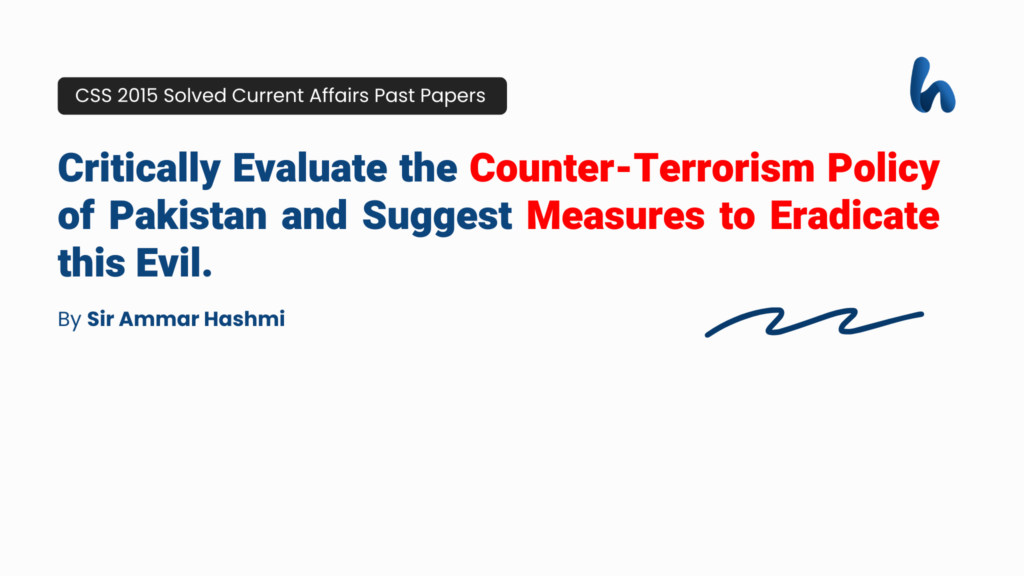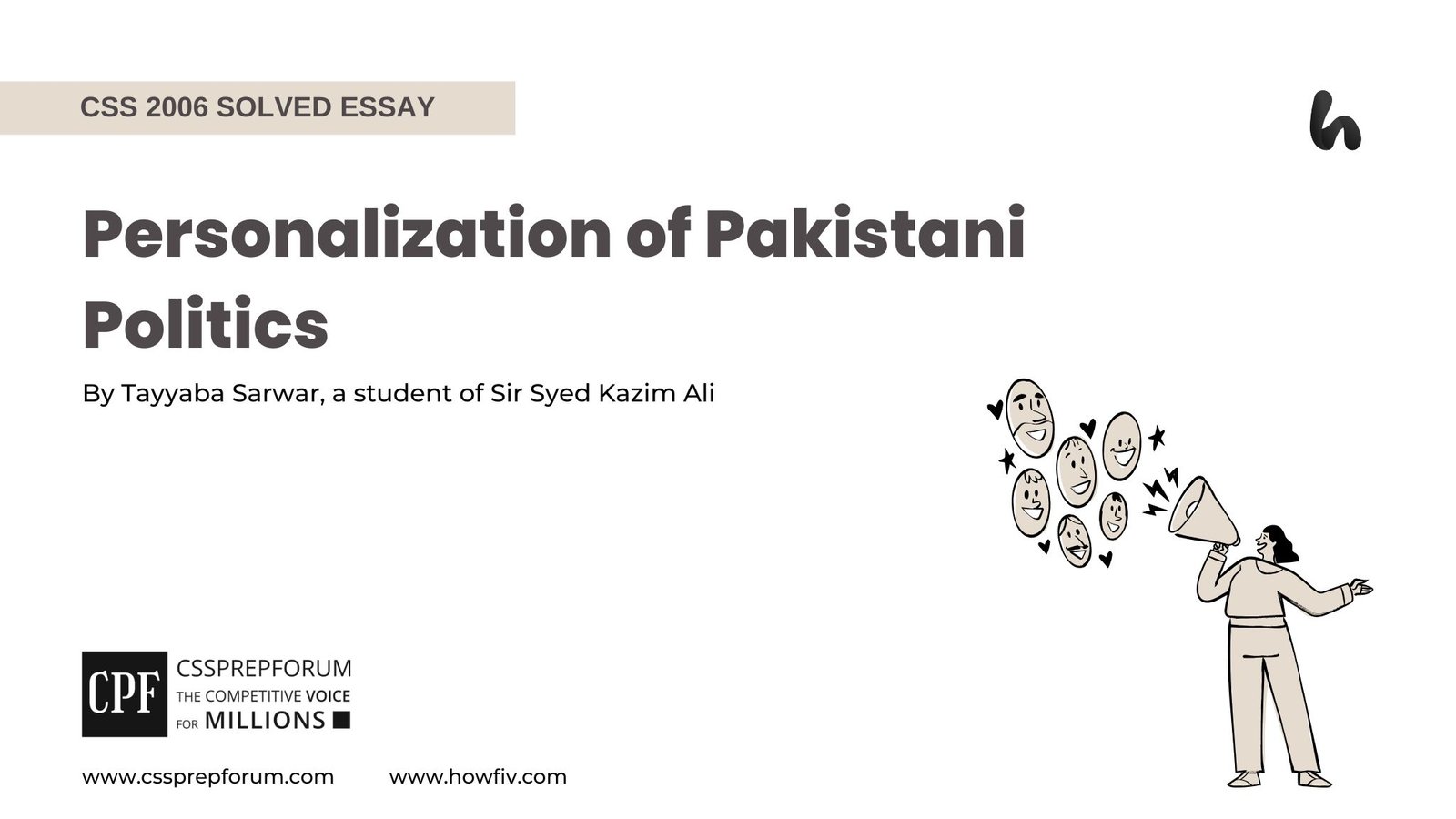CSS 2015 Solved Current Affairs Past Papers | The Counter-Terrorism Policy of Pakistan
The following question of CSS Current Affairs 2015 is solved by Sir Ammar Hashmi, the best Current Affairs Coach, on the guided pattern of Sir Syed Kazim Ali, which he taught to his students, scoring the highest marks in compulsory subjects for years. This solved past paper question is uploaded to help aspirants understand how to crack a topic or question, how to write relevantly, what coherence is, and how to include and connect ideas, opinions, and suggestions to score the maximum.

Question breakdown
The question has two parts. The first requires an evaluation of Pakistan’s current counter-terrorism policy, while the second requires suggesting measures to eradicate the evil.
Outline
1-Introduction
2-Pakistan’s Counter-Terrorism Policy
3-Critical Evaluation of Pakistan’s Counter-Terrorism Policy
- ✓ Selective Targeting of Militant Groups
- ✓ Madrassa Reforms: A Missed Opportunity
- ✓ Socio-Economic Factors and the Persistence of Extremism
4-Suggested Measures to Eradicate Terrorism
- ✓ Strengthening Policy Implementation
- ✓ Judicial and Legal Reforms
- ✓ Enhanced Intelligence and Security Operations
- ✓ Addressing Radicalization and Extremism
- ✓ Socioeconomic Development and Rehabilitation Programs
- ✓ Community and International Cooperation
5-Critical Analysis
6-Conclusion

Answer to the question
Introduction
Pakistan has conducted many operations, such as Zarb-e-Azb and Radd-ul- Fasaad to neutralize terrorists in the tribal regions of Pakistan, especially North Waziristan, which served as a stronghold of the militants. Out of many policies drafted against terrorism, the National Action Plan (NAP) was the most significant one. It is a twenty-point agenda to counter-terrorism, eliminate their networks, and curb and prevent extremism. Several challenges inviolate Pakistan’s policies against terrorism to date. One of the key problems is the selective targeting of militant groups; where militant groups like TTP have been weakened, a few other militias like Jaish-e-Mohammed and Lashkar-e-Taiba, surfaced in the region and are involved in political activity under different mantles. Hence, only a comprehensive approach which engulfs dialogue, rehabilitation and international cooperation is needed to wipe out terrorism in Pakistan and achieve sustainable peace.
Pakistan’s Counter-Terrorism Policy
Pakistan’s counter-terrorism policy is primarily based on the National Action Plan (NAP) launched in 2015 after the disastrous terrorist attack on the Army Public School in Peshawar. NAP is a twenty-point agenda against militias and terrorists, for dismantling the terrorist organizations, for controlling terror and terrorism. Pakistan has conducted many such operations, including Zarb-e-Azb and Radd-ul-Fasaad, which resulted in the elimination of terrorist activities in the tribal areas of Pakistan, particularly in North Waziristan, where the terrorists enjoy their free grounds. Similarly, the execution of the plan under intelligence operations was also a notable factor in the success of this policy. For instance, coordination between security agencies such as (Inter-Services Intelligence (ISI)) and the National Counter Terrorism Authority (NACTA). Apart from armed offensives, Pakistan has initiated changes or introduced new measures into madrassas to re-map their operations and try to curb the further emergence of extremism. The federal government, to some extent, appreciates the concept of an integrated approach in the fight against terrorism, which includes military, social as well as political. Although much progress has been made in preventing terrorist attacks despite the successful prevention and fight against some groups, challenges still remain. The effectiveness of such policies are believed to be contingent on the continuation of these policies, the political willingness and serious earnestness to counterterrorism in its entirety, regional security, and cooperation with neighbouring countries.
Critical Evaluation of Pakistan’s Counter-Terrorism Policy
Counter-terrorism policy in Pakistan was set after 2015 through the National Action Plan (NAP), which had a visible success in decreasing terrorism. The operations, Zarb-e-Azb (2014-2017) and Radd-ul-Fasaad (2017-present), successfully cleared militants in tribal areas of North Waziristan. As of now, Pakistan has experienced external and internal security threats. The Institute for Conflict and Security Studies (PICSS) estimates that roughly 45% of the incidence of terrorism was reduced in 2020 as compared to statistics from 2015. Such militant groups as Tehreek-e-Taliban Pakistan (TTP) and other high-profile militant groups suffered major losses, their main leaders having been eliminated or driven across the Afghan border. Pakistan also introduced impressive improvements in intelligence-based operations with the help of NACTA, where as many as 1,200 terrorists were convicted under anti-terrorism laws.
- ✓ Selective Targeting of Militant Groups:
Zarb-e-Azb was launched under NAP in 2014, which targeted the terrorist sanctuaries in North Waziristan. It successfully disrupted major networks of terrorists, for instance, Al-Qaeda and TTP affiliates, which have lately enhanced their capacity to stage large attacks. More than 3500 terrorists were killed, and thousands of their nests were eliminated by the end of December 2016. Likewise, Operation Radd-ul-Fasaad was conducted in 2017 to wage an operation against the residual threat. It was not only a military operation but also meant to improve counter-terrorism laws and to limit funding sources for terrorist actions. The primary issue that can be singled out is the choice of the militant groups to be targeted. Where TTP has been countered, a few other groups like Jaish-e-Mohammed and Lashkar-e-Taiba surfaced in the same geographical sphere and participated in political processes. This has aroused international criticism of Pakistan regarding its overall activities against terrorism and has undermined its authority.
- ✓ Madrassa Reforms: A Missed Opportunity:
A three-pronged strategy of the National Action Plan was developed to review the funding for the madrassas and their curriculum as well. Similarly, the activation of the Interior Ministry, in collaboration with the Ministry of Religious Affairs, aimed to form a Madrassa Regulatory Authority to make sure that these institutions follow the education systems that encourage humanity and non-violent principles. Also, in Pakistan Penal Code and the Anti-Terrorism Act (ATA), changes were made in order to define hate speech as a crime. International Crisis Group, however, said that attempts made to control the 30,000 madrassas have not yielded much progress, as observed by some religious groups. Further, the reforms of the madrassa also continue to be less implemented.
- ✓ Socio-Economic Factors and the Persistence of Extremism:
Other than military and espionage-related activities, structural problems such as poverty, lack of education, and joblessness churn out extremism in Pakistan. Therefore, while the government has only concentrated itself on military operations, the relative lack of socio-economic reform turned into a source of radicalization. Failing to address economic issues, social status, and educational rights became a permanent source of extremism and terrorism and may remain a problem, leading to limited sustainable peace. In addition, Pakistan has had outstanding results with a dominant strategy, but more work is still required in the fields of reintegration, policy stability, governance, and economic growth.
Suggested Measures to Eradicate Terrorism
- ✓ Strengthening Policy Implementation:
Pakistan’s policies, like the National Action Plan (NAP), provide a comprehensive approach, but its weak implementation has often limited its impact. Addressing this gap is essential as it would help close the loopholes that terrorists exploit, which will reduce their influence and operational capacity. One example in this context is the regulation of madrassas, often cited as breeding grounds for fundamentalism due to the lack of oversight on curriculum. Despite NAP promises, less than 10% of the country’s madrassas will be brought under formal regulation by 2020. Here, policy strengthening ensures that all madrassas are registered under the government with a standardized curriculum. Interior Ministry reported in 2022 that more than $100 million of unmonitored funds flowed into religious institutions without proper regulations. Sectarian violence is another key point that has suffered poor enforcement under NAP. Despite bans, groups like Sipah-e-Sahaba and Lashkar-e-Jhangvi continue to operate under different names, indicating a 28% rise in sectarian violence compared to 2019. Moreover, statistical evidence further supports the view that robust policy implementation is a key driver in successfully eradicating terrorism.
- ✓ Judicial and Legal Reforms:
Strengthening the judicial system is essential in Pakistan to stop and eradicate illegal activities from its society. For this, assurance is needed that the courts are fully equipped to handle terrorism-related cases fairly or if the state needs to enhance the rule of law. For instance, the establishment of specialized anti-terrorism courts can expedite trials that can, visibly reduce the backlog of cases and ensure timely justice. Still, according to the International Crisis Group, Pakistan’s anti-terrorism courts have delayed proceedings, which led to prolonged detention without trial and promoted militant groups to exploit legal loopholes. Additionally, current laws on financing terrorism and monitoring systems hinder terrorist operations, and they need to be updated. Moreover, training of police and other security forces helps them operate more effectively and ethically. A study conducted by the United Nations Office on Drugs and Crime showed that well-trained law enforcement is crucial in the prevention of terrorist acts and building public trust. However, these reforms in Pakistan can efficiently combat terrorism by ensuring timely justice, covering legal loopholes, enhancing law enforcement capabilities and supporting victims.
- ✓ Enhanced Intelligence and Security Operations:
For intelligence and security operations, improvement in intelligence gathering is essential as pre-emptive action against potential terrorist threats. Good investments in advanced surveillance technologies and training personnel can help in better detection and disruption of terrorist plots before they materialize. For example, the National Counter Terrorism Authority in Pakistan aimed to coordinate various security agencies, leading to more effective counter-terrorism strategies. In addition, collaboration among the military, intelligence agencies and police can lead to more comprehensive data analysis and quicker response times. Moreover, targeting the logistics of terrorist organizations through improved intelligence can disrupt their operations. The Financial Action Task Force also emphasizes the importance of tracking the transaction activities of suspected terrorist groups to break their funding sources. The Institute for Economics and Peace indicated that countries with efficient intelligence operations experience lower rates of terrorism. These measures can create a more proactive counter-terrorism framework, contributing to national security and stability.
- ✓ Addressing Radicalization and Extremism:
When it comes to combating radicalization and extremism, educational changes and improvements have huge potential; for example, school curricula using critical thinking cultivation and programs that educate people on how to live with different religions and cultures will go a long way in fighting radicalism. For instance, the Pakistan Peace Collective has developed an educational curriculum that fosters interfaith dialogue and critical analysis among youth. The De-radicalization Programs can also be initiated by various NGOs in Pakistan, like the Pakistani Red Crescent Society, which focuses on providing support to individuals who may be susceptible to extremist ideologies. Moreover, extremist groups often use social media to spread their ideology, so social media monitoring in today’s digital age is crucial. Statistically, the Global Extremism Monitor analyzed that countries with effective counter-radicalization strategies experience lower rates of extremism; for example, through community engagement and education, successful interventions in areas like Swat have led to decreased recruitment into extremist groups.
- ✓ Socio-economic Development and Rehabilitation Programs:
The role of these efforts is to promote the change in living standards of violently affected communities and offer a stable future instead of Islamic extremism. Employment and skills are part of socio-economic relations, and they are common in reform agendas that help eliminate poverty and endow individuals with their citizenship rights. For instance, the Benazir Income Support program gives monetary assistance to low-income families so they don’t end up being a part of extremism. Besides this, spending on infrastructure is an important component of rehabilitation to address the fundamental needs that can improve primary standards, including education, fresh and improved water, food, shelter, and healthcare. Also, social cohesiveness and community relations are necessary for efforts to restore social and communal relations and trust among people. Such programs aim to promote tolerance between different communities and are suitable measures that could help reduce feelings that lead to extremism. United Nations Development Programme also highlighted that socio-economic advancement greatly minimizes the propensity for violence, whereas rehabilitation programme initiation has significantly reduced the recruitment rates of these groups.
- ✓ Community and International Cooperation:
In the fight against terrorism, the collaboration of local knowledge, global material and human resources was established to develop adequate measures. In this regard, focusing on this evil in engaging local communities will assist and encourage citizens to embrace law enforcement agencies, thus replacing apathy with rapport. For example, the Community Engagement Programs by different NGOs in Pakistan have effectively been able to influence mainstream Pakistani leaders to collaborate with the police to enhance their security and reduce membership enrollment with other such violent groups. Several treaties with the United States and China have already been signed that allowed the sharing of information and cooperation between operations, which enhanced the overall counter-terrorism capability of the country. Secondly, internationally backed capacity-building programs can help improve local law enforcement. Another way of strengthening operational readiness and cooperation is through cooperative counter-terrorism operations with other countries. The Shanghai Cooperation Organization is currently undertaking an endeavour that allows member countries to exchange and learn from one another regarding combating terrorism.
Critical Analysis
The government has used some measure that comprises military operations and legislative measures, which are usually missing a holistic approach to some of the root causes of terrorism, such as poverty, social injustice and lack of adequate education. That is why it is assumed that if community engagement is not employed, the current policy may offer only short-term remedies instead of fundamental judicial reforms and socio-economic development. At the same time, complete reliance on military force without addressing the remaining issues may lead to the continuation of the strife. Hence, it calls for a combination of measures stressing negotiation, demining and reintegration and international cooperation to eliminate terrorism in Pakistan and strengthen the peace process.
Conclusion
Terrorism in Pakistan requires an integrated approach rather than mere military, eliminating the menace while at the same time dealing with the consistent and continued social, economic and political problems. If implemented, the four perspectives of a comprehensive strategy of community cooperation, socio-economic development, judicial reforms, and improved intelligence activities in Pakistan can greatly help combat terrorism. As for the objectives, new efforts with regard to international cooperation and trust-building among different communities will be necessary to counter radicalization and extremism. Thus, the created and effective collaborative and inclusive strategy will not only advance the sphere of national security but, at the same time, gradually and inexorably open the way to a stable and long-awaited peaceful future for the region as a whole and free from terrorism.

CSS Solved Past Papers’ Essays
Looking for the last ten years of CSS and PMS Solved Essays and want to know how Sir Kazim’s students write and score the highest marks in the essays’ papers? Then, click on the CSS Solved Essays to start reading them.
CSS Solved Essays
CSS Solved General Science & Ability Past Papers
Want to read the last ten years’ General Science & Ability Solved Past Papers to learn how to attempt them and to score high? Let’s click on the link below to read them all freely. All past papers have been solved by Pakistan’s top CSS GSA coach having the highest score of their students.
General Science & Ability Solved Past Papers












